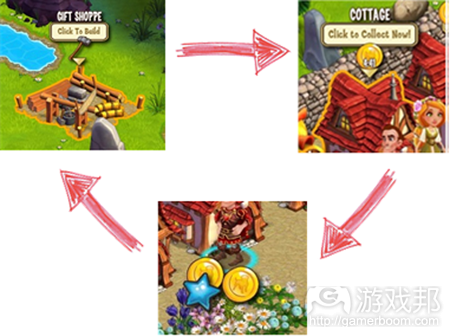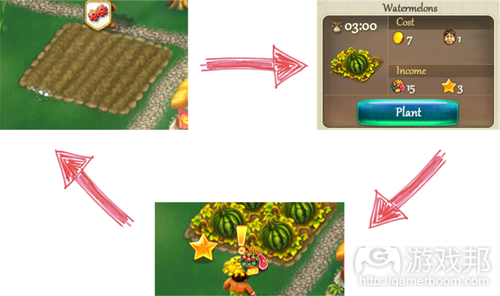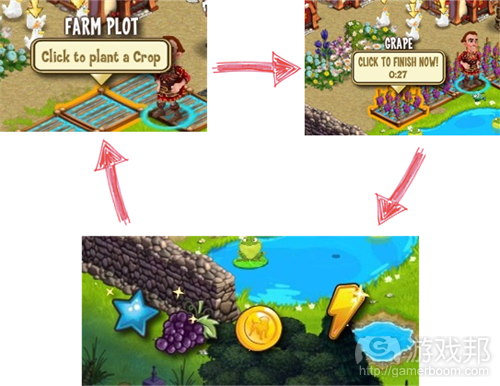举例阐述游戏循环的意义及其设计方法
作者:Danila Yudin
引言
我从Andrei Plakhov的文章《For game designers about programmers: how to program programmers》中受到启发,我认为玩家行为也是可以被设计的。为了娱乐玩家、确保玩家持续消费,以及理解如何吸引新玩家,设计玩家是很重要的。用于吸引玩家的工具之一是程序中的一系列功能,即所谓的“游戏循环”。
1、“游戏循环”是什么?为什么需要“游戏循环”?
内容是游戏的基础部分。一方面它决定了玩家的能力,另一方面它决定了开发一款游戏所需的工作量。这也是玩家返回游戏的原因。同时,游戏内容的大部分活动呈周期性循环。我发现所有的社交游戏都是重复的,这种重复即“游戏循环”。
游戏循环——由此至终贯穿游戏过程的一序列活动。例如:建造-等待-获益。
游戏可以没有游戏循环吗?——有这个可能。但想象一下,在游戏当中,只有线性(非循环的)内容。一个小时又一个小时过去了,玩家会看到所有新的美术、动画、迷你游戏、听到新的音乐。这种游戏需要多大的空间?多长的开发时间?多长的安装时间?我们进入游戏,看到某些类似故事剧情或包含大量特殊活动的长期任务。如果以这种方式组织游戏内容,开发一款有趣的游戏会非常困难,也很费时间。
我们习惯于快速游戏和简单挣钱。为了解决这些问题,我们引入了相同活动的重复。这种活动链条形成了游戏。
读完上文后,你可能仍然有疑惑:为什么要用游戏循环,为什么要遵循游戏循环?当然,简单地说就是,为了创造有趣的、清楚而容易开发的产品。考虑以下积极影响:
玩家容易掌握游戏。2到3个简单的动作比又长又难的动作序列好记多了。
游戏需要的内容更少,程序更小,方便玩家快速下载。想象一下,如果一款游戏需要100个小时才能完成,玩家参加每一个5分钟的活动,都必须等上30分钟才能看到结果。由此可知,利用游戏循环可以将游戏的容量缩小至上百倍。这样的游戏既保证了游戏时长,又不需要占用太多电脑资源。
所有游戏都存在游戏循环。大概是因为开发者们懒于多做这个工作:
FPS:购买武器-杀死对手-得到金钱
任务:解决谜题-得到道具-完成任务
休闲游戏:得到谜题-解决谜题-得到积分
MMORPG:购买道具-赢得战斗-得到奖励
社交游戏:建造房屋-种植-繁殖-等待-收益
2、典型的游戏循环(建造、PvP、PvE)
建造:
在社交游戏中,我们可以定义玩家的活动,如收割农作物和制作东西,为一种建造类的游戏循环。在这一类游戏循环中,玩家花大量时间用于等待,而我们则把这段时间变得有趣。
PvE:
在游戏中存在不可操作的角色(NPC),NPC给玩家发放任务、破坏玩家的建筑物和农田。这种与环境之间的交互作用的循环就是所谓的PvE。这一类循环更加动态,因为玩家不需要任何等待。玩家通常必须对NPC作出快速反应。AI使游戏更加有趣。
PvP:
我们称第三类循环,即玩家之间的交互作用为PvP。在战争型游戏和和平型游戏中,玩家的目标是帮助自己的朋友、得到礼物和完成游戏。这类循环是最重要的。玩家之间适当的交互作用是最有趣的。
3、和平型和战争型游戏中的游戏循环
社交游戏以游戏循环为基础,以获得更多积分作为朋友之间的竞争形式。在和平型游戏中,玩家因建造、任务和帮助朋友而获得好评。这些指标通常是等级、城市的花费或成就的数量。玩家可以互相帮助、增加各自的积分、能量等等。在战争型游戏中,玩家可以通过进攻获得积分。这些循环是类似的。唯一的区别是,在和平游戏中,互动对双方都有利,而在战争型游戏中,玩家的目标只是获胜。
4、游戏循环的作用是什么?
应该模仿现实生活中的人类活动;
开始和过程都应该简单;
活动序列应该短且容易记忆和重复;
游戏世界需要玩家。这里应该要有提醒玩家返回游戏的内容;
游戏机会应该渐进地提供给玩家。这确保了玩家有成长、发展和获得新内容的机会;
应该以积极的方式结束。恭喜!完成游戏的孩子都有糖吃!
5、知名游戏中的游戏循环案例
案例1:《Castleville》
1、选择建筑物,购买,等待收益,经过固定的一段时间后开始挣钱,然后建造另一座建筑物,再重复。
2、在游戏中,我们有花坛可以种植物。选择一个花坛,种植,等待然后收获。
《Castleville》中的游戏循环非常简单。玩家基本上是在做机械运动。
案例2:《The Tribez》
1、选择建筑物,购买,等待收益,重复。许多游戏都存在这个循环。
2、在游戏中,我们有花坛可以种植物。选择一个花坛,选择植物种植,等待然后收获。以上两款游戏中的游戏循环是类似的。
总而言之,伴随式技巧——是简化循环的另一种方法,但仍然不提倡滥用复杂性。
6、如何开始游戏循环?
玩家登录游戏后,从哪里开始呢?我们应该向玩家解释他们应该做什么。否则,玩家很快就会厌烦,然后改玩其他游戏。如何进入游戏循环,往往让许多玩家感到焦虑,他们极有可能因此一去不返。在游戏中,开发者应该训练玩家如何进入游戏循环,以及向玩家说明基本的操作。第一个游戏循环的最佳开头是,一个“点击我”的按钮。之后, 玩家学到积极的经验之后,就会知道怎么处理空荡荡的花坛,或饥肠辘辘的奶牛。游戏循环的开始应该伴随着一些炫丽的特效(游戏邦注:如闪烁的按钮、特殊的声音等等)。
如何在游戏循环中跟进玩家?
在一个实验,将老鼠大脑中的“愉悦中心”连上电极。当老鼠拉动控制杆,一股小电流就会刺激“愉悦中心”,老鼠因此在那一小段时间内感到非常愉快,以至于忘记了周围的一切,甚至是生存的必需活动,如吃和喝。就这样,老鼠死了(但是,它们是快乐死的)。作为游戏设计师,我们希望玩家就是这些老鼠,而游戏就是“快乐的”控制杆。在整个游戏循环中,玩家应该知道下一步要做什么,和“快乐的”控制杆在哪里。这个控制杆可以是达成目标的奖励等等,玩家必须感到他们的努力得到回报。奖励的“强度”应该与达到的目标的重要性一致。达到目标后,应该把玩家引向新的目标。玩家应该能够衡量他们自己是否达到了自己的目标(例如,用计时器显示何时收获农作物)。
8、如何结束游戏循环?
在游戏循环的末期,玩家应该心满意足地离开游戏世界。他应该感到他已经完成了所有可以做的事。他应该收到奖励和新任务。让玩家在游戏循环末期感到愉快,这一点非常重要。
9、断点型游戏循环
我们已经考虑了最常用的简单的游戏循环。但为了诱使玩家,必须把游戏做得像活物一样。游戏就像塞壬唱着诱人的歌,让可怜的玩家像海上的水手一样神昏颠倒,不顾一切地走进游戏世界。
游戏循环的完成不需要很长时间。当玩家建造了东西,等待五分钟,然后获得一些“不错的东西”。这些循环通常很短,但玩家在玩游戏时,足以形成一个完整的循环。还有另一种更费时间的游戏循环。一般来说,这类循环的完成需要两个或以上的游戏环节。这类循环叫作断点型游戏循环。例如,我们可以种植一些“大南瓜”。一旦这些南瓜成熟,我们就会收到许多奖励和经验点。自然而然地,这种南瓜需要整整187375个小时才能成熟。如果你是一个正常人,你大概没有办法玩上这么久的游戏(骨灰级玩家也做不到吧)。你不可能一直在游戏上,你得抽时间去探访朋友、溜狗或者旅游。但是,一旦“大南瓜”成熟,你非常可能会回到游戏。
如果你的游戏中存在游戏循环,你必须保证有一两个是断点型游戏循环,以确保玩家继续玩你的游戏。断点型游戏循环是将玩家留在游戏中的主要工具。
10、如何利用?
作为游戏设计师,你必须解决以下三个基本问题:
如何吸引玩家?
如何留住玩家?
如何让玩家消费?
吸引新玩家的艺术是另一篇文章的主题,故略过。至于留住玩家,你要利用高效的断点型游戏循环。它让玩家产生一种印象,认为游戏仍然在进行,即使玩家不在游戏中,这样就会让关闭游戏后的玩家之后又回到游戏中。
11、总结
怎样引诱玩家不断地玩游戏?这个问题没有唯一的答案。这里有几个基本点是成功的游戏必不可少的:
任何游戏都有游戏循环。
游戏循环——游戏的主要部分,应该让玩家觉得愉快、自我感觉良好。
必须教玩家如何玩这款游戏。
这款游戏必须至少有一个断点型游戏循环。(本文为游戏邦/gamerboom.com编译,拒绝任何不保留版权的转载,如需转载请联系:游戏邦)
To game designer about the players or how to program players?
by Danila Yudin
I have thought a lot about game development and I have analyzed information about it. I wrote and published this article to share with people. I want to get feedback, hints, tips and comments about this article. Today game design requires a more scientific approach, which requires a special consideration. Unfortunately there is very little structured information available for free. Now international and experienced authors’ works are extremely difficult to find. There people share their experience and impressions of develop games. These works not only convey new information to readers but they also allow a more clear understanding of game design.
Introduction
I will start my article when Henric Suuronen’s performance on Sociality Rocks 2011. He is the head of the studio Wooga, developer Bubble Island and other hits. Of particular note is an article by Andrei Plakhov “For game designers about programmers: how to program programmers”. In accordance this article I believe that players can also be programmed. It’s important to program players in order to entertain them, insure that they continue to pay, as well as understanding how to attract new customers. One of the tools which can be used for attracting players is a set of functions in the application, called the “game loop”. This is what we’ll continue to.
1. What is the “game loop”? Why is it needed?
Content is the basic part of the game. On the one side it determines the ability of users. On the other side it determines the amount of work needed to create a project. It is the reason why users will come back to a game. At the same time most of the action in the process of this content is cyclically repeated. am very smart and I have noticed that all these social games is repeated. These cyclings are called “game loops”.
The game loop – a sequence of actions performed throughout the game over and over again. For example: the construction of the building, waiting, obtaining foreign currency, the construction of the building, waiting, etc.
Can we do without game loops? – Yes It is possible. But let’s imagine that in our project, there is only linear (not looped) content. For hours and hours, players will see all new art, animations, mini-games, hear new music. How much space will this game take? How long will it take to be developed? How long will it take to install? We go into this game and see something like a storyline or a long quest with plenty of unique activities. It is complicated and time consuming to come up with an interesting game in this manner.
We are used to fast games and easy money. To solve these problems we introduce the repetition of the same action with different appearances. This chain of action forms the game.
After reading that last paragraph you might still be wondering why you should use a gaming loop and why you need to follow them. Of course the simple answer is to create an interesting, clear and easy to develop product. Consider the positive effects:
· The user can easily master the game. 2-3 simple actions are easier to remember than long complicated sequences of actions.
· They requires less content, smaller applications, faster loading time. Let’s imagine that game takes 100 hours to complete. For each 5 minute action, a user must wait 30 minutes for an output. Using this, you can see that using game loops can reduce the size of your application by hundreds of times. The result is that you have a game that is both long to play, and that takes up very little of the computer’s resources.
Game loops exist in all games. Because developers are too lazy and would rather eat donuts than work.:
FPS: buy weapons – kill opponents – get money;
Quest: solve puzzle – get item – complete quest;
Casual Arcade: get puzzle – solve puzzle – get high score;
MMORPG: buy items – win battles – get reward;
Social Games: build a house – planted a tree – grown son –- wait – get profit.
2. Typical game loops (housing, PvP, PvE)
Housing:
Look at social games. In them we can define the following player’s actions – harvesting crops building and crafting things – these activities refer to the type of game loops of Housing. In this type of game loops people can spend a lot of time waiting and we can make this time sweet.
PvE
Then, in the game there are non playable characters (NPC), which give quests, attack buildings and crops, etc. There is a loop of interaction with the environment named PvE. This type is more dynamic because you do not need to wait for anything. You usually need to act quickly in response to the behavior of the game character. Artificial intelligence makes the game more interesting
PvP
The third type of loop is the interaction with other players. In war games, as well as peaceful games, your goal is too help your friends, get gifts, as well as to complete. We call this Player vs player (or player for player in peaceful games). This type of loop is the most important. Proper interaction with other players is the most interesting interaction for the public.
3. Game loops in peace and war games
Social games are built on game loops to get more points as form of competition with friends. In peace games players compete to get credit for buildings, quests and helping friends. These indicators are generally levels, the cost of the city, or the number of achievements. Players can help each other, increasing the amount of their points, energy, etc. In war games users can get points for attacks to increase their performance and characteristics. These loops are similar. The only difference is that in peaceful games the interaction benefits both parties, and in war games, just winning.
4. What should game loops do?
● it should simulate the actions of people in real life;
● it should run easily both the first and in subsequent times;
● it should be short, the sequence can be easily memorized and repeated over and over again;
● the game world has need of the player. It should have reminders that the player needs to come back;
● play opportunities should be provided to a person gradually. This is to ensure that the player had an opportunity to grow, develop and access new content;
● It should end positively. Congratulations! Here’s a candy from the shelf;
5. Examples of game loops in well known games.
Example 1 (Castleville):
1. Choose the building, buy it, and wait for a profit, after a fixed time make money, then build another building, and repeat.
Fig. 1. – Game loop: construct building – waiting – profit.
2. In the game we have flower beds on which to grow plants. Choose a flower bed, plant the plant, wait and then collect your harvest.
Fig. 2. – The game loop: put the plant – waiting – profit.
Game loops in Castleville are very simple. The players essentially become a machine.
Example 2 (The Tribez):
1. Select the building, buy it, wait for a profit, get it and repeat. This loop is typical for many games.
2. We have flower beds on which to grow plants. Choose a flower bed, chose the plant, wait and then collect your harvest. Games loop in both game are similar.
Fig. 3. – Game loop: select plant – waiting – profit
Fig. 4 – The game loop: the construction of the building – waiting for – profit
It can be concluded that the accompanying tips – an alternative to the simplicity of the cycle, but the complexity of the abuse is still not worth it.
6. How to start a game loop?
Here you are logged into the game. Where to start? We should explain to the player what they should do. If we do not the player will become quickly bored, and choose another game. This is often upsetting to many players, and it is very unlikely they will come back. In the game you need to enter training that will teach players how to enter the game loop, as well as explain the basic controls. The best beginning of the first game loop will be a button that says “click me”. In the future, the player, having learned from positive experiences,will know what to do if they see an empty flower bed, or a hungry cow. The game loop should be started with some sort of effect (for example with a flashing button, special sounds, etc.)
7. How to follow players through the game loop?
There was an experiment with rats where an electrode was hooked up to the “pleasure center” of their brain. When the rats pulled the lever, a small electrical charge stimulated the “pleasure center”, and they felt a euphoric rush for a short amount of time. It was so pleasurable, that the rats ignored everything around them. They even ignored the basic necessities for life, such as eating and drinking. They ended up dying (but hey, they died happy). As game designers, we want the player to be the rat, and the game to be the “feel good” lever. Throughout the game loop a player should know what to do next and where his “feel good” lever is. This lever could be anything from getting an award to accomplishing goals. This process should be intuitive (after, of course, listening to the tutorial). After an accomplishment, a player must feel rewarded for their efforts. The “intensity” of the reward should correlate with the importance of the goal that was met. After meeting a goal, a player should be introduced to a new goal or target. A player should be able to measure whether or not they reach their goals (For example, having a timer to show when they need to harvest their crops).
8. How to finish a game loop
At the end of the game cycle the user should be left the impression that everything in his game world is good. He should have the feeling that he did all he could do. He should receive an award and be presented with a new responsibility. It is very important that a player feel happy at the end of a game loop.
9. Broken game loops
We have considered simple game cycles that are used most often. But in order to entice the player to make the game look like a living creature. For example, the game must feel like a siren singing an irresistible song to the poor gamer. He must feel so enticed by it, that he sails to her regardless of the consequences it may bring.
Game loops do not take very long to complete. When you build something, you wait for five minutes, and then get some “cool thing”. These loops are often short enough to go through a complete cycle while the user is playing the game. There are other game cycles that take much longer to cycle through. Normally such cycles take two or more gaming sessions to complete. Such cycles are called broken game loops. For example, we can plant some “mega-pumpkins”. Once these pumpkins have matured, we will receive many bonuses and experience points. Naturally, such pumpkins take 187,375 hours to mature. If you are a normal person (with a life) there is a chance you won’t be able to play a game for 187,375 hours straight (all bets are off for hard core gamers). Because you must leave the game to visit with friends, play with your dog, or visit Bangladesh, you are much more likely to come back when the “mega-pumpkins” have matured
If your game has game loops you must include a broken game loop or two to insure the player continues to play your game. A broken game loop the main tool in keeping the user in the game.
10. How can we use it?
As a game designer, you must solve three basic problems:
● how to attract players;
● how to keep them;
● how to make them pay.
Unfortunately, the art of attracting new players is a topic of another article. As for keeping users, you can use the highly effective broken game loop. This creates the impression that the game is continuing even in the absence of the player and thus helps users to continue to come back after closing the application.
11. Summary
How to you make a game that will entice the user into playing it over and over again? There is no universal answer to this question. Here are the basic points, without which a successful game is almost impossible to make:
● every game has game loops;
● game loop – the main part of the game, which should make the player smile and feel good about himself;
● a player must be taught how to play the game;
● the game must have at least one broken game cycle.(source:gamasutra)











































 闽公网安备35020302001549号
闽公网安备35020302001549号